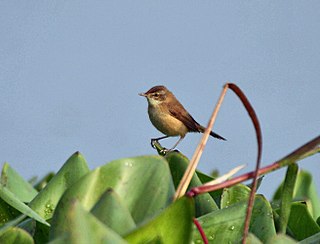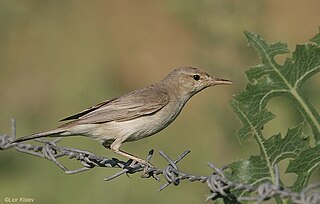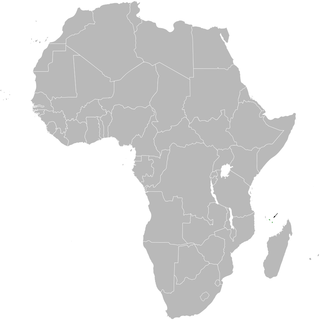Old World warblers are a large group of birds formerly grouped together in the bird family Sylviidae. They are not closely related to the New World warblers. The family held over 400 species in over 70 genera, and were the source of much taxonomic confusion. Two families were split out initially, the cisticolas into Cisticolidae and the kinglets into Regulidae. In the past ten years they have been the subject of much research and many species are now placed into other families, including the Acrocephalidae, Cettiidae, Phylloscopidae, and Megaluridae. In addition some species have been moved into existing families or have not yet had their placement fully resolved. A smaller number of warblers, together with some babblers formerly placed in the family Timaliidae and the parrotbills, are retained in a much smaller family Sylviidae.

The Acrocephalus warblers are small, insectivorous passerine birds belonging to the genus Acrocephalus. Formerly in the paraphyletic Old World warbler assemblage, they are now separated as the namesake of the marsh and tree warbler family Acrocephalidae. They are sometimes called marsh warblers or reed warblers, but this invites confusion with marsh warbler and reed warbler proper, especially in North America, where it is common to use lower case for bird species.

Hippolais is a genus of tree warbler in the family Acrocephalidae. It is sometimes associated with the genus Iduna. The genus name Hippolais is from Ancient Greek hupolais, as misspelt by Linnaeus. It referred to a small bird mentioned by Aristotle and others and may be onomatopoeic or derived from hupo,"under", and laas, "stone".

The thick-billed warbler breeds in the temperate east Palearctic, from south Siberia to west Mongolia. It is migratory, wintering in tropical South Asia and South-east Asia. It is a very rare vagrant to western Europe.

The paddyfield warbler is a species of marsh warbler. It was formerly included in the "Old World warbler" assemblage. The Manchurian reed warbler was included in A. agricola as a subspecies.

The eastern olivaceous warbler is a small passerine bird with drab plumage tones, that is native to the Old World. For the most part it breeds in southeastern Europe, the Middle East and adjacent western Asia, and winters in the northern Afrotropics.

The booted warbler is an Old World warbler in the tree warbler group. It was formerly considered to be conspecific with Sykes's warbler, but the two are now usually both afforded species status. Booted warbler itself breeds from central Russia to western China, and migrates to winter in the Indian subcontinent as far south as Sri Lanka. Booted warbler has expanded its breeding range westward in recent decades and nests now as far west and north as Finland. It is a small passerine bird, found in open country with bushes and other tall vegetation. Three or four eggs are laid in a nest in a bush or vegetation. Like most warblers they are insectivorous.

Sykes's warbler is an Old World warbler in the tree warbler family. It was formerly considered a subspecies of the booted warbler, but is now considered a full species. Its breeding range is from northeast Arabia to Turkestan, west China and Afghanistan. Like the booted warbler, many populations of the species migrate in winter to the Indian subcontinent as far south as Sri Lanka.

The Acrocephalidae are a family of oscine passerine birds, in the superfamily Sylvioidea.

The mountain yellow warbler or mountain flycatcher-warbler is a species of Acrocephalidae warbler; formerly, these were placed in the paraphyletic "Old World warblers".

Grauer's warbler is a species of Old World warbler in the family Acrocephalidae.

The Grande Comore brush warbler is a species of Old World warbler in the family Acrocephalidae. It is found in Comoros and Mayotte. Its natural habitat is subtropical or tropical moist montane forests.

The subdesert brush warbler, also known as Lantz's brush-warbler, is a species of Old World warbler in the family Acrocephalidae. It is found only in Madagascar.

The Anjouan brush warbler is a species of Old World warbler in the family Acrocephalidae. Clements lumps this bird into the Malagasy brush warbler N. typica. This is supported by the IUCN, whereas the IOC recognizes it as a valid species. It is endemic to the Comoros and Mayotte.

The Moheli brush warbler is a species of Old World warbler in the family Acrocephalidae. It is found only in Comoros. Its natural habitat is subtropical or tropical moist montane forests.

The Malagasy brush warbler, also known as the Madagascar brush-warbler, is a species of Old World warbler in the family Acrocephalidae. It is found in Comoros and Madagascar. Its natural habitats are subtropical or tropical dry forests, subtropical or tropical moist lowland forests, and subtropical or tropical moist shrubland.

The chestnut-headed tesia is a small insectivorous songbird formerly of the "Old World warbler" family but nowadays placed in the bush warbler family (Cettiidae).

The Nauru reed warbler is a passerine bird endemic to the island of Nauru in the Pacific Ocean. It is one of only two native breeding land-birds on Nauru and it is the only passerine found on the island. It is related to other Micronesian reed warblers, all of which evolved from one of several radiations of the genus across the Pacific. Related warblers on nearby islands include the Caroline reed warbler, with which the Nauru species was initially confused, and the nightingale reed warbler, which was formerly sometimes considered the same species.

Iduna is a genus of tree warbler in the family Acrocephalidae. Keyserling and Blasius gave no explanation of the genus name Iduna. It is sometimes lumped in the genus Hippolais, although in 2009 it was found to belong to the Iduna clade.
















